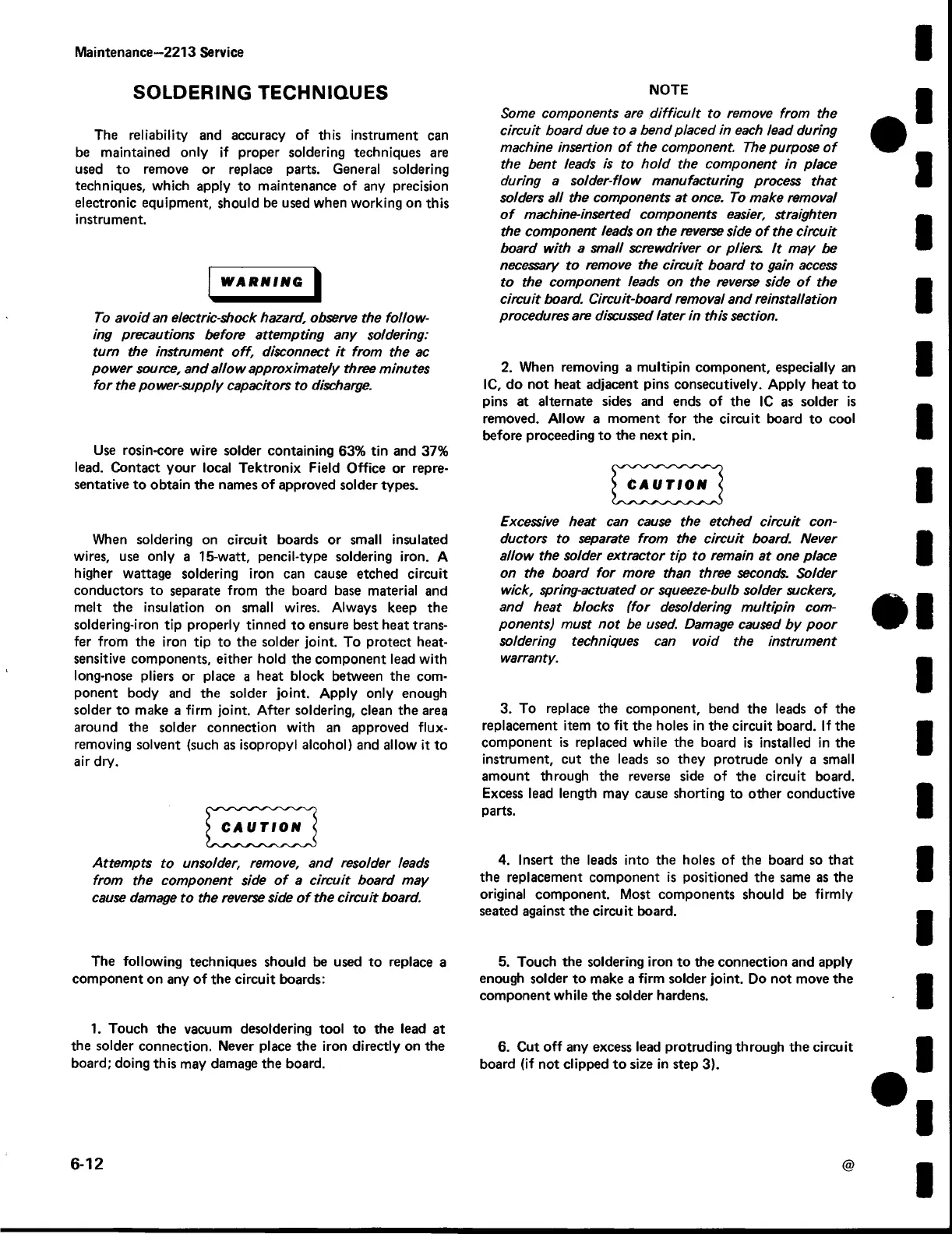Maintenance—2213 Service
SOLDERING TECHNIQUES
The reliability and accuracy of this instrument can
be maintained only if proper soldering techniques are
used to remove or replace parts. General soldering
techniques, which apply to maintenance of any precision
electronic equipment, should be used when working on this
instrument.
WARMING
To avoid an electric-shock hazard, observe the follow
ing precautions before attempting any soldering:
turn the instrument off, disconnect it from the ac
power source, and allow approximately three minutes
for the power-supply capacitors to discharge.
Use rosin-core wire solder containing 63% tin and 37%
lead. Contact your local Tektronix Field Office or repre
sentative to obtain the names of approved solder types.
When soldering on circuit boards or small insulated
wires, use only a 15-watt, pencil-type soldering iron. A
higher wattage soldering iron can cause etched circuit
conductors to separate from the board base material and
melt the insulation on small wires. Always keep the
soldering-iron tip properly tinned to ensure best heat trans
fer from the iron tip to the solder joint. To protect heat-
sensitive components, either hold the component lead with
long-nose pliers or place a heat block between the com
ponent body and the solder joint. Apply only enough
solder to make a firm joint. After soldering, clean the area
around the solder connection with an approved flux-
removing solvent (such as isopropyl alcohol) and allow it to
air dry.
Attempts to unsolder, remove, and resolder leads
from the component side o f a circuit board may
cause damage to the reverse side o f the circuit board.
The following techniques should be used to replace a
component on any of the circuit boards:
1. Touch the vacuum desoldering tool to the lead at
the solder connection. Never place the iron directly on the
board; doing this may damage the board.
NOTE
Some components are difficult to remove from the
circuit board due to a bend placed in each lead during
machine insertion o f the component. The purpose o f
the bent leads is to hold the component in place
during a solder-flow manufacturing process that
solders all the components at once. To make removal
o f machine-inserted components easier, straighten
the component leads on the reverse side o f the circuit
board with a small screwdriver or pliers, it may be
necessary to remove the circuit board to gain access
to the component leads on the reverse side o f the
circuit board. Circuit-board removal and reinstallation
procedures are discussed later in this section.
2. When removing a multipin component, especially an
1C, do not heat adjacent pins consecutively. Apply heat to
pins at alternate sides and ends of the 1C as solder is
removed. Allow a moment for the circuit board to cool
before proceeding to the next pin.
Excessive heat can cause the etched circuit con
ductors to separate from the circuit board. Never
allow the solder extractor tip to remain at one place
on the board fo r more than three seconds. Solder
wick, spring-actuated or squeeze-bulb solder suckers,
and heat blocks (for desoldering m ultipin com
ponents) must not be used. Damage caused by poor
soldering techniques can void the instrument
warranty.
3. To replace the component, bend the leads of the
replacement item to fit the holes in the circuit board. If the
component is replaced while the board is installed in the
instrument, cut the leads so they protrude only a small
amount through the reverse side of the circuit board.
Excess lead length may cause shorting to other conductive
parts.
4. Insert the leads into the holes of the board so that
the replacement component is positioned the same as the
original component. Most components should be firmly
seated against the circuit board.
5. Touch the soldering iron to the connection and apply
enough solder to make a firm solder joint. Do not move the
component while the solder hardens.
6. Cut o ff any excess lead protruding through the circuit
board (if not clipped to size in step 3).
6-12
@

